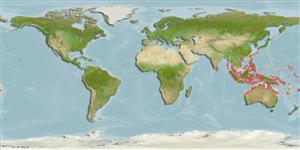>
Kurtiformes (Nurseryfishes, cardinalfishes.) >
Apogonidae (Cardinalfishes) > Apogoninae
Etymology: More on authors: Smith & Radcliffe.
Environment: milieu / climate zone / depth range / distribution range
Écologie
marin récifal; profondeur 2 - 20 m (Ref. 37816). Tropical; 30°N - 24°S
Indo-West Pacific: Malaysia east to Palau in Micronesia and the Solomon Islands, north to the Ryukyu Islands and south to the Great Barrier Reef.
Taille / Poids / Âge
Maturity: Lm ? range ? - ? cm
Max length : 12.0 cm TL mâle / non sexé; (Ref. 9710); common length : 8.5 cm SL mâle / non sexé; (Ref. 37816)
Épines dorsales (Total): 8; Rayons mous dorsaux (Total): 9; Épines anales 2; Rayons mous anaux: 9. Color is white or pinkish with about six red-brown stripes on side; 3-4 dark spots at the base of the caudal fin. Eyes iridescent blue. Small juveniles have yellow caudal peduncle with black spot in centre, mimicking the large-toothed Cheilodipterus species. That enables them to swim about more freely (Ref. 48635).
Found in small aggregates among or near mounds of branching corals such as Porites cylindrica or P. nigrescens (Ref. 1602). Nocturnal species (Ref. 7300). Has been reared in captivity (Ref. 35404).
Life cycle and mating behavior
Maturité | Reproduction | Frai | Œufs | Fécondité | Larves
Mouthbrooders (Ref. 240). Distinct pairing during courtship and spawning (Ref. 205).
Myers, R.F., 1991. Micronesian reef fishes. Second Ed. Coral Graphics, Barrigada, Guam. 298 p. (Ref. 1602)
Statut dans la liste rouge de l'IUCN (Ref. 130435)
Menace pour l'homme
Harmless
Utilisations par l'homme
Aquarium: potentiel
Plus d'informations
RéférencesAquacultureProfil d'aquacultureSouchesGénétiqueElectrophoresesHéritabilitéPathologiesTraitementNutrientsMass conversion
Outils
Articles particuliers
Télécharger en XML
Sources Internet
Estimates based on models
Preferred temperature (Ref.
123201): 26.6 - 29.3, mean 28.7 °C (based on 2141 cells).
Phylogenetic diversity index (Ref.
82804): PD
50 = 0.5000 [Uniqueness, from 0.5 = low to 2.0 = high].
Bayesian length-weight: a=0.00933 (0.00519 - 0.01678), b=3.06 (2.90 - 3.22), in cm total length, based on LWR estimates for this species & (Sub)family-body (Ref.
93245).
Niveau trophique (Ref.
69278): 3.5 ±0.50 se; based on food items.
Résilience (Ref.
120179): Haut, temps minimum de doublement de population inférieur à 15 mois (Preliminary K or Fecundity.).
Fishing Vulnerability (Ref.
59153): Low vulnerability (10 of 100).
Nutrients (Ref.
124155): Calcium = 126 [78, 217] mg/100g; Iron = 0.95 [0.59, 1.49] mg/100g; Protein = 19.1 [18.1, 20.1] %; Omega3 = 0.158 [0.101, 0.248] g/100g; Selenium = 26.4 [14.9, 47.5] μg/100g; VitaminA = 90.5 [33.3, 242.3] μg/100g; Zinc = 1.86 [1.28, 2.59] mg/100g (wet weight);
